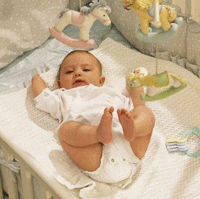Listen up, parents: the American Academy of Pediatrics (AAP) is expanding its advice about safe sleep for your baby and here’s what you’ve got to know:
- Crib bumpers are out: the only things in your baby’s crib should be a tight-fitting sheet around a properly sized mattress and your infant
- Breastfeeding is recommended: and is directly linked to reducing SIDS
- Get your baby vaccinated: immunizations can reduce her SIDS risks by 50%
Since the AAP launched the Back to Sleep campaign in 1992, directing parents to put babies to sleep on their backs, deaths from Sudden Infant Death Syndrome (SIDS) have declined.
The newly revised guidelines (the last updates were in 2005), comes at a time when sleep-related deaths, including suffocation, entrapment and asphyxia, are increasing. So, this time around, the AAP is addressing specific steps you can take to make your baby’s sleep environment safer.
“We have tried to make it easier for parents and providers to understand the recommendations by providing specific answers to common questions,” said Rachel Moon, MD, FAAP, chair of the AAP SIDS task force and lead author of the new guidelines. ”
In 2005, the AAP stopped short of banning bumpers altogether and instead told parents to only use bumpers that were “not pillowlike,” meaning thin, firm and well-secured. And that’s because the evidence was just not there that bumpers caused infant deaths, Dr. Moon, said.
Since that time, new evidence, as well 27 several bumper-related deaths, have shown that bumpers can indeed impede the air exchange in a crib, putting a baby in harm’s way. In half of those deaths, in babies from 1 month old to 2 years, infants suffocated when they became wedged between the bumper pad and the crib, the others were sadly strangled by the bumper’s ties.
The new recommendations also mean that babies should not have loose bedding, blankets, toys, stuffed animals or any other items around them in their cribs, and that they should always be put to sleep on their backs in a cool room.
In making their recommendations, the pediatricians group also advised that you and your caregivers should:
- Always place your baby on his or her back for every sleep time.
- Always use a firm sleep surface. Car seats and other sitting devices aren’t recommended for routine sleep.
- Keep your newborn/infant in your room in her or his own bed, but not in your bed (room-sharing without bed-sharing).
- Keep soft objects or loose bedding out of the crib. This includes pillows, blankets, and bumpers.
- Never use wedges and or other sleep positioners.
- Never smoke during pregnancy or around your baby after birth.
- Always breastfeed your baby or bottle feed breastmilk – this is proven in research to reduce SIDS risks.
- Offer a pacifier at nap time and bedtime.
- Never cover your baby’s head or allow it to overheat in too many layers or clothing or in a warm room.
- Don’t use home monitors or commercial devices marketed to reduce the risk of SIDS; instead, practice these proven safe sleep habits.
- Give your baby all of its recommended vaccinations – this will cut your baby’s SIDS risks by as much as 50%
- Daily provide supervised, awake tummy time to promote your baby’s proper development and to prevent flat head syndrome from spending too much time on her or his back.






Comments are closed.